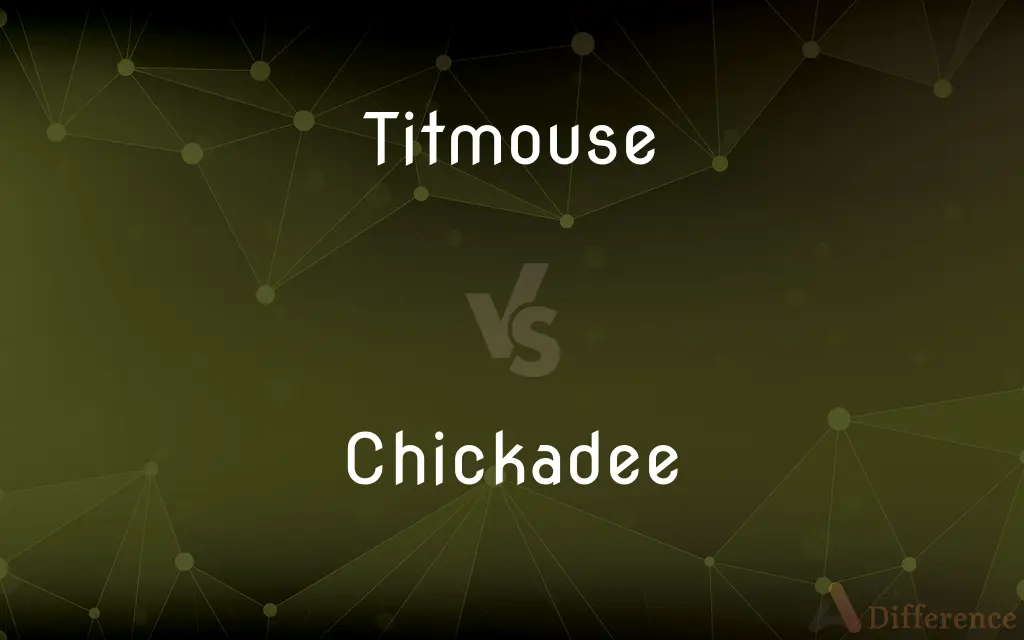Titmouse vs. Chickadee — What's the Difference?
By Fiza Rafique & Urooj Arif — Updated on March 29, 2024
Titmice are small, plump birds with gray, black, and white plumage, known for their agility and loud calls. Chickadees are tiny, active birds with distinctive black caps and bibs, recognized for their "chick-a-dee" call and friendliness towards humans.

Difference Between Titmouse and Chickadee
Table of Contents
ADVERTISEMENT
Key Differences
Titmice, belonging to the family Paridae, are characterized by their soft, gray plumage and a notable crest on their heads, which can signal their mood. They are often found in wooded areas and are known for their strong, acrobatic flying abilities. Whereas chickadees, also members of the Paridae family, are easily identifiable by their black caps and bibs, along with their cheerful and complex "chick-a-dee-dee-dee" calls. Chickadees have a remarkable ability to remember thousands of hiding places for their food.
In terms of behavior, titmice are quite bold and curious, often seen investigating feeders and humans, showing less fear than many other birds. They are also known for their loud, clear calls and songs. On the other hand, chickadees exhibit a friendly nature towards humans, often approaching them closely and showing little fear, making them favorites among birdwatchers.
Regarding their diet, both titmice and chickadees are omnivorous, feeding on a mix of insects, seeds, and berries. However, chickadees have a particular penchant for seeds and can often be seen hanging upside down to pick at seed heads and cones, showcasing their agility.
In terms of habitat, while both prefer wooded areas, titmice are more likely to inhabit deciduous and mixed forests, often staying within the same area year-round. Chickadees are more adaptable and can be found in a variety of forest types, from deciduous to evergreen, and they have a wider range across North America, including urban and suburban areas.
Social structures between the two also show variations. Titmice often form long-term pair bonds and can be seen in small family groups or mixed-species flocks outside of the breeding season. Chickadees, however, are known for their complex social hierarchies and are often found in large, mixed-species flocks, which helps them find food and avoid predators more efficiently.
ADVERTISEMENT
Comparison Chart
Appearance
Gray plumage, crested head
Black cap and bib, no crest
Call
Loud, clear calls
"Chick-a-dee-dee-dee," complex and cheerful
Behavior
Bold, curious, less interactive with humans
Extremely friendly, approaches humans closely
Diet
Omnivorous: insects, seeds, berries
Omnivorous: prefers seeds, exhibits agility in feeding
Habitat
Deciduous and mixed forests, stable territories
Adaptable, wide range including urban areas
Social Structure
Forms pair bonds, seen in small groups or mixed flocks
Complex social hierarchies, large mixed-species flocks
Compare with Definitions
Titmouse
Prefers deciduous and mixed forests.
A pair of titmice nested in the old oak tree.
Chickadee
Tiny birds with distinctive black caps and bibs.
A chickadee landed on my hand at the park.
Titmouse
Small birds with a gray body and crested head.
The tufted titmouse visited the bird feeder early in the morning.
Chickadee
Recognized for their "chick-a-dee" call.
The sound of chickadees filled the winter air.
Titmouse
Known for their agility and loud calls.
The piercing call of the titmouse echoed through the forest.
Chickadee
Found in a variety of forest types and urban areas.
Chickadees visited the feeder in the suburban backyard.
Titmouse
Less interactive with humans than chickadees.
The titmouse watched cautiously from a branch above.
Chickadee
Exhibits friendliness towards humans.
Chickadees often approach birdwatchers closely.
Titmouse
Forms long-term pair bonds.
The bonded titmice foraged together throughout the year.
Chickadee
Feeds on seeds and insects, showing remarkable agility.
The chickadee hung upside down to peck at a sunflower seed.
Titmouse
Any of several small insectivorous songbirds of the family Paridae of woodland areas, especially members of the genus Baeolophus, such as the tufted titmouse.
Chickadee
The chickadees are a group of North American birds in the tit family included in the genus Poecile. Species found in North America are referred to as chickadees, while other species in the genus are called tits.
Titmouse
Any small passerine bird of the family Paridae, which are found in the woods of the Northern Hemisphere and of Africa.
Chickadee
Any of several small plump North American birds of the genus Poecile, having predominantly gray plumage and a dark crown.
Titmouse
Any one of numerous species of small insectivorous singing birds belonging to Parus and allied genera; - called also tit, and tomtit.
Chickadee
A small passerine bird (songbird) of the genus Parus or the family Paridae.
Titmouse
Small insectivorous birds
Chickadee
Affectionate term of address.
Chickadee
A small bird, the blackcap titmouse (Parus atricapillus), of North America; - named from its note.
Chickadee
Any of various small gray-and-black songbirds of North America
Common Curiosities
Are titmice friendly to humans?
Titmice are curious and bold but less likely to approach humans closely compared to chickadees.
What do chickadees eat?
Chickadees are omnivorous, with a preference for seeds, and are known for their agile feeding behaviors.
What is the social structure of titmice?
Titmice form long-term pair bonds and may join small groups or mixed-species flocks outside the breeding season.
How can you attract chickadees to your garden?
Providing bird feeders with seeds, especially sunflower seeds, and ensuring a safe environment can attract chickadees.
Are chickadees part of a larger bird family?
Yes, chickadees belong to the Paridae family, which includes titmice and other small, perching birds.
How do chickadees communicate?
Chickadees communicate through a variety of calls, including their distinctive "chick-a-dee" call, which has different meanings.
Can you hand-feed chickadees?
Chickadees are among the few wild birds that can be hand-fed, due to their friendly nature towards humans.
What distinguishes a titmouse from a chickadee?
Titmice have gray plumage and crested heads, while chickadees are known for their black caps and cheerful calls.
Can titmice and chickadees be found in the same habitat?
Yes, both prefer wooded areas but chickadees have a wider range and adaptability, including urban settings.
How do titmice and chickadees differ in their feeding habits?
While both are omnivorous, titmice may be less acrobatic in their feeding compared to the agile chickadees.
Do titmice migrate?
No, titmice generally stay within the same area year-round, preferring stable territories.
What role do titmice play in their ecosystem?
As insectivores, titmice help control insect populations, benefiting their habitats.
How do chickadees survive the winter?
Chickadees have a remarkable memory for locating food caches and can lower their body temperature at night to conserve energy.
What makes chickadees adept at surviving in various habitats?
Their adaptability, memory for food locations, and social structures make chickadees resilient across diverse environments.
Why are chickadees often seen in mixed-species flocks?
Joining mixed-species flocks allows chickadees to find food more efficiently and enhances their protection against predators.
Share Your Discovery

Previous Comparison
Bohemian vs. Hipster
Next Comparison
Morphological vs. PhenotypeAuthor Spotlight
Written by
Fiza RafiqueFiza Rafique is a skilled content writer at AskDifference.com, where she meticulously refines and enhances written pieces. Drawing from her vast editorial expertise, Fiza ensures clarity, accuracy, and precision in every article. Passionate about language, she continually seeks to elevate the quality of content for readers worldwide.
Co-written by
Urooj ArifUrooj is a skilled content writer at Ask Difference, known for her exceptional ability to simplify complex topics into engaging and informative content. With a passion for research and a flair for clear, concise writing, she consistently delivers articles that resonate with our diverse audience.














































